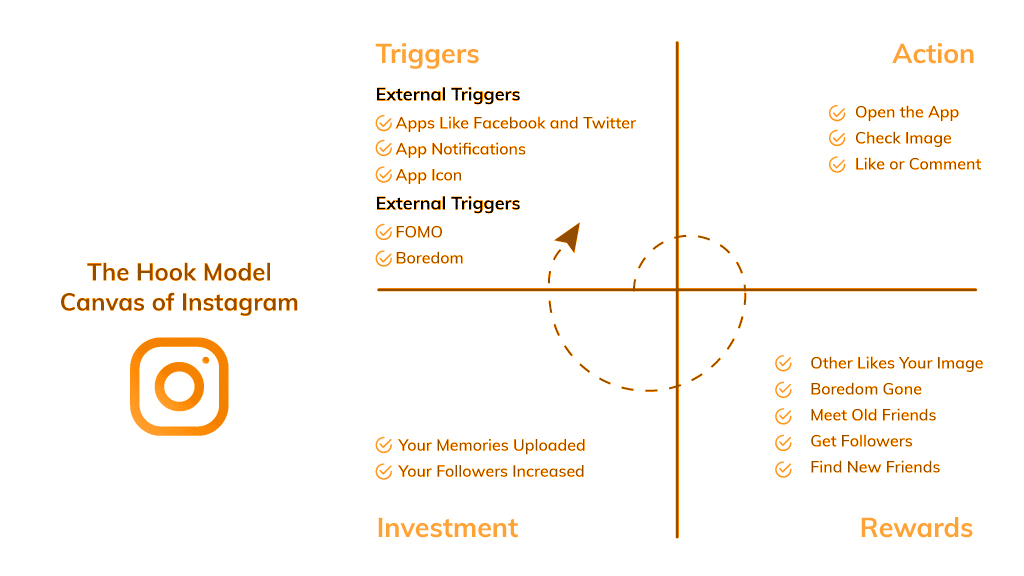Product Led Growth Knowledge Base
Pre-Reads
Week 1
https://theproductfolks.notion.site/Week-1-11c3c1641b574509876217db5b300609
Product Led Growth is a go-to-market strategy that relies on using your product as the main vehicle to acquire, activate, and retain customers.
Week 2
Product Led Growth is accomplished when companies maximize product use to drive acquisition, conversion, retention, and expansion.
2 Popular Product Led Growth Frameworks
- Growth Loops :ATTACH:
Growth loops are closed systems where the inputs produce further outputs, which can be reinvested in the input by certain processes. Growth loops are used to create various attributes, like new users, users returned, protection, or performance.

- The Hook Model :ATTACH:
The Hook Model is a four-phase method that companies may use to build goods or services widely used by consumers. The aim is to result in a voluntary, high-frequency commitment.

The Hook Model consists of the following stages:
- *Trigger (External or Internal):* this is the behavioral actuator. It signals the action that builds a habit.
- *Action*: Actions carried out in expectation of reward.
- *Variable Reward*: The dilemma that has been addressed as a result of the action taken reinforces the behavioral loop. The reward styles include the rewards of the Tribe (social rewards based on association and acceptance), the rewards of the Hunt (search for material resources), and the rewards of the Self (personal satisfaction in the form of mastery or self-fulfillment).
- *Investment*: An activity that will develop the product or service in the future.
Instagram’s Hook Model

Moving Forward
Are you familiar with the pirate metrics known as AAARRR
Here are the 6 metrics of the Pirate Funnel AAARRR
- *Awareness* – The number of people your product reaches. (Awareness was not included in Dave McClure’s original Pirate Funnel, but it was later added by Growth Tribe in 2016.)
- * *Acquisition**** – The number of people who visit your website and sign up for your free trial.
- *Activation* – The number of people who are taking the first step. (For example, sign up, download an app, or submit their first comment.)
- Retention* – The number of people who come back for a second/third/tenth time.
- *Revenue* – The number of people who start paying for your product. And how much they pay.
- *Referral* – The number of people who recommend your company to their friends.
And the Product-Led Growth Flywheel
Retention Rate
Customer retention is a strong indicator of the fact that users keep finding value in your product through their journey.
Churn Rate
Churn means customers ending their relationship with your company for any reason.
Stickiness
Stickiness Factor is an important metric that you want at a high rate. It will tell you a lot about the strengths and weaknesses of your product.
Feature Adoption Rate
Feature Adoption Rate is at the forefront of many metrics that you need to track for a SaaS product’s success, and it is so much related to the metrics above. Feature adoption rate = number of users of a feature / number of users of the product
Refer to more articles on Adoption and Activation
Product-Qualified Leads (PQLs)
PQLs can simply be described as the users who are activated as a result of completing key actions in your product and finding value through those actions.
Time to Value (TTV)
Time to Value refers to the amount of time that it takes your users to reach their Aha! Moment.
Your goal is to reduce time to value so that you can have high retention rates. Providing an excellent onboarding experience, you should guide your users to finding the value.
Customer Lifetime Value (CLV)
LTV is a great metric when it comes to building up a long-term strategy. By segmenting customers taking CLV into account, your company’s teams can make important decisions about which type of customers to target and how much effort, time, and money they should spend to acquire new customers and retain existing customers.
Additional Resources
Week 3
What are you really measuring in a product-led growth model?
- Trial-to-paid conversion rate
- Activation rate
- Churn rate
- Engagement Score
- DAU, WAU, MAU (daily, weekly, monthly active users)
The Three Elements You Need To Master Product-Led Growth
- Step 1: Understand Your Value
- Step 2: Communicate the Perceived Value of Your Product
- Step 3: Deliver on What You Promise
- Minimizing Friction
- Driving Demand
Week 4
- Becoming product-led: What does it mean?
- Identifying Growth KPIs that are leading indicators of product success
- Metrics that matter
- Case Study#3 : Inside Booking.com’s experimentation culture
- Case Study#1: Netflix : ‘The 10,000 Experiment Mindset’
- The Surprising Power of Online Experiments
Week 5
- User-First Monetization — Lessons from Instagram and Strava
- Drive Your Growth – Monetize Your Innovations
- Product Monetization Strategies
- Thinking in Bets: Making Smarter Decisions When You Don’t Have All the Facts
- Misbehaving: The Making of Behavioural Economics